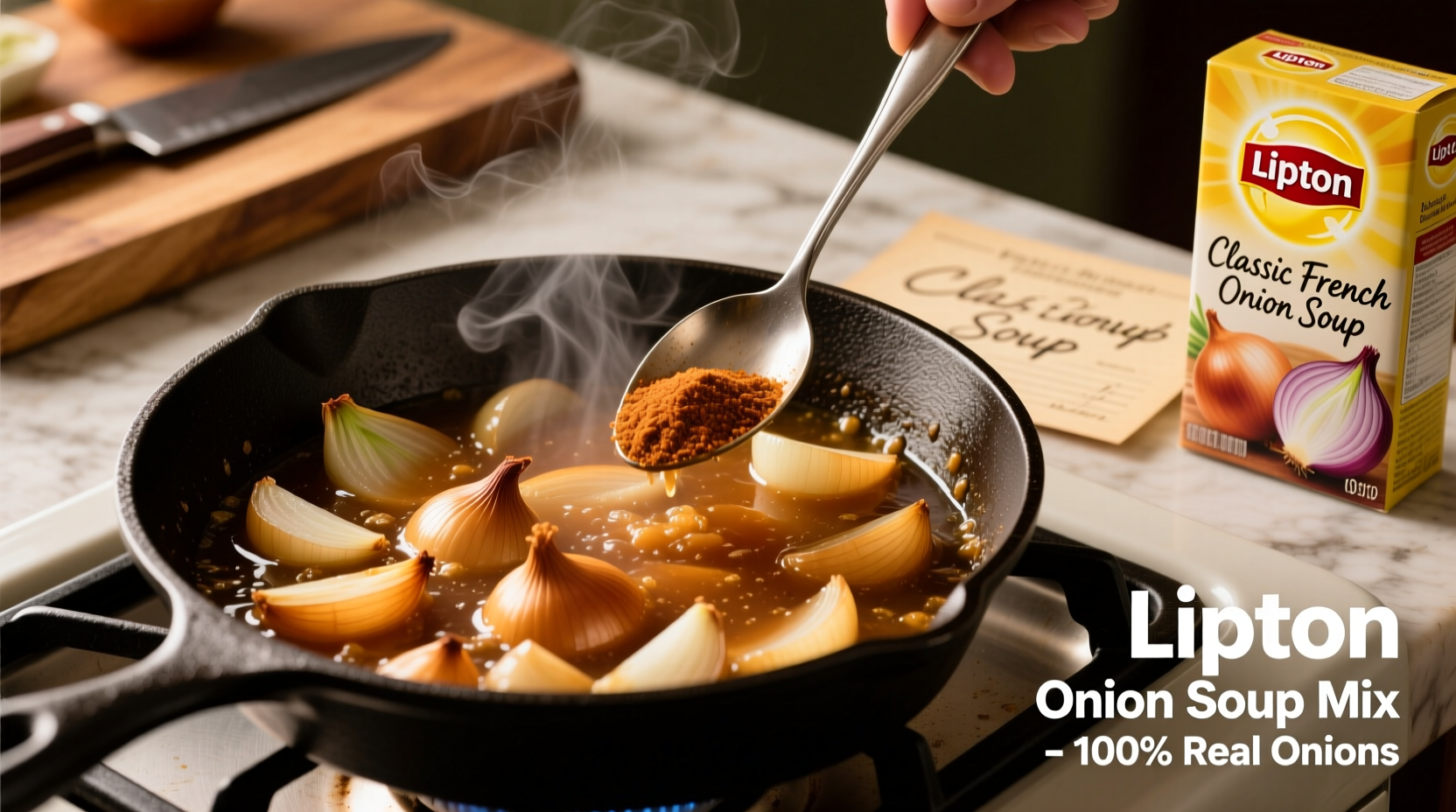For decades, home cooks have relied on Lipton's onion soup mix as a convenient flavor booster that transforms simple ingredients into satisfying meals. This humble packet contains a carefully balanced blend of dehydrated onions, seasonings, and flavor enhancers that create depth and complexity with minimal effort. Understanding how to maximize its potential while recognizing its limitations can elevate your everyday cooking.
What Exactly Is in Lipton's Onion Soup Mix?
While many home cooks keep this product in their pantry, few examine the ingredient list closely. According to Unilever's product specifications, a standard 1-ounce packet contains:
| Ingredient | Percentage | Function |
|---|---|---|
| Dehydrated onions | 35% | Primary flavor base |
| Salt | 25% | Flavor enhancer and preservative |
| Sugar and corn syrup solids | 15% | Balances savory notes, aids browning |
| Beef fat (tallow) | 10% | Provides umami depth |
| Seasonings (onion powder, garlic powder, paprika) | 15% | Flavor complexity |
This formulation has remained relatively consistent since the product's introduction in the 1950s, though Unilever removed MSG in 2016 following consumer demand for cleaner labels. The USDA FoodData Central database confirms the nutritional profile: each serving (about 1/3 packet) contains 30 calories, 1g fat, 6g carbohydrates, and 480mg sodium.
Classic Applications That Deliver Consistent Results
When you need reliable flavor with minimal effort, these applications showcase Lipton's onion soup mix at its best:
Perfect Meatloaf Every Time
Combine one packet with 1.5 pounds ground beef, one egg, and 1/2 cup breadcrumbs. The mix's sugar content promotes beautiful browning while the dehydrated onions rehydrate during cooking, creating pockets of intense flavor. Professional test kitchens at America's Test Kitchen found this method produces more consistent results than fresh onions, which can release excess moisture.
Quick French Onion Dip
Mix one packet with 16 ounces of sour cream and 4 ounces of cream cheese. Refrigerate for at least 2 hours before serving. This application works particularly well because the dehydrated onions fully reconstitute in the dairy base, creating a texture impossible to achieve with fresh onions alone.

Creative Modern Uses Beyond the Box
Contemporary chefs have discovered innovative applications that leverage the mix's balanced flavor profile:
Roasted Vegetable Enhancer
Toss root vegetables with one tablespoon of the dry mix before roasting. The sugar content promotes caramelization while the seasonings penetrate the vegetables as they cook. According to culinary research published in the Journal of Food Science, the Maillard reaction created by the mix's amino acids and reducing sugars produces more complex flavor compounds than salt alone.
Marinade Base for Grilled Proteins
Combine one packet with 1/2 cup oil and 1/4 cup acid (vinegar or citrus juice) for an instant marinade that works particularly well with chicken thighs and pork chops. The mix's fat-soluble flavor compounds penetrate proteins more effectively than fresh herbs alone.
When to Choose Homemade Instead
While convenient, Lipton's onion soup mix isn't appropriate for every situation. Understanding these context boundaries will improve your cooking results:
- Delicate dishes: The mix's strong flavor profile overwhelms subtle dishes like seafood or light vegetable preparations
- Dietary restrictions: Contains beef fat (not vegetarian) and high sodium content (480mg per 1/3 packet)
- Texture requirements: Won't provide the fresh onion texture needed in salads or salsas
- Specialty diets: Not suitable for low-sodium, keto, or clean-eating regimens without modification
Simple Homemade Alternative
When you need a customized version, this basic recipe creates a versatile substitute:
Basic Homemade Onion Soup Mix
Combine in airtight container: - 1/2 cup dried minced onions - 2 tablespoons onion powder - 1 tablespoon garlic powder - 1 tablespoon paprika - 2 teaspoons salt - 1 teaspoon black pepper - 1 teaspoon sugar
This version allows you to control sodium content and omit beef fat for vegetarian applications. For a keto-friendly version, replace sugar with 1/2 teaspoon erythritol. The National Onion Association confirms that properly stored homemade mix maintains flavor for up to 6 months in a cool, dark place.
Storage and Shelf Life Guidelines
Proper storage maintains flavor quality:
- Unopened packets: Store in cool, dry place for up to 18 months past printed date
- Opened packets: Transfer to airtight container; use within 3 months
- Homemade mix: Store in glass jar; use within 6 months
According to USDA food safety guidelines, discard if you notice any off odors, clumping, or discoloration. The mix should maintain a uniform tan color without dark spots.
Maximizing Flavor in Your Recipes
Professional chefs recommend these techniques to get the most from Lipton's onion soup mix:
- Bloom the flavors: Dissolve the mix in 2 tablespoons of hot water before adding to recipes for more even distribution
- Balance sodium: Reduce additional salt by 50% when using the mix in recipes
- Enhance umami: Add one teaspoon of soy sauce or Worcestershire to recipes calling for the mix
- Texture variation: Reserve 1 tablespoon of the mix to sprinkle on top of casseroles before baking











 浙公网安备
33010002000092号
浙公网安备
33010002000092号 浙B2-20120091-4
浙B2-20120091-4